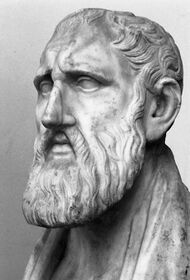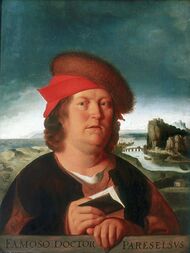Astronomy:Microcosm–macrocosm analogy

The microcosm–macrocosm analogy (or, equivalently, macrocosm–microcosm analogy) refers to a historical view which posited a structural similarity between the human being (the microcosm, i.e., the small order or the small universe) and the cosmos as a whole (the macrocosm, i.e., the great order or the great universe).[lower-alpha 2] Given this fundamental analogy, truths about the nature of the cosmos as a whole may be inferred from truths about human nature, and vice versa.[1]
One important corollary of this view is that the cosmos as a whole may be considered to be alive, and thus to have a mind or soul (the world soul), a position advanced by Plato in his Timaeus.[2] Moreover, this cosmic mind or soul was often thought to be divine, most notably by the Stoics and those who were influenced by them, such as the authors of the Hermetica.[3] Hence, it was sometimes inferred that the human mind or soul was divine in nature as well.
Apart from this important psychological and noetic (i.e., related to the mind) application, the analogy was also applied to human physiology.[4] For example, the cosmological functions of the seven classical planets were sometimes taken to be analogous to the physiological functions of human organs, such as the heart, the spleen, the liver, the stomach, etc.[lower-alpha 3]
The view itself is ancient, and may be found in many philosophical systems world-wide, such as for example in ancient Mesopotamia,[5] in ancient Iran,[6] or in ancient Chinese philosophy.[7] However, the terms microcosm and macrocosm refer more specifically to the analogy as it was developed in ancient Greek philosophy and its medieval and early modern descendants.
In contemporary usage, the terms microcosm and macrocosm are also employed to refer to any smaller system that is representative of a larger one, and vice versa.
History

Antiquity
Among ancient Greek and Hellenistic philosophers, notable proponents of the microcosm–macrocosm analogy included Anaximander (c. 610 – c. 546 BCE),[8] Plato (c. 428 or 424 – c. 348 BCE),[9] the Hippocratic authors (late 5th or early 4th century BCE and onwards),[10] and the Stoics (3rd century BCE and onwards).[11] In later periods, the analogy was especially prominent in the works of those philosophers who were heavily influenced by Platonic and Stoic thought, such as Philo of Alexandria (c. 20 BCE – c. 50 CE),[12] the authors of the early Greek Hermetica (c. 100 BCE–300 CE),[13] and the Neoplatonists (3rd century CE and onwards).[14] The analogy was also employed in late antique and early medieval religious literature, such as in the Bundahishn, a Zoroastrian encyclopedic work, and the Avot de-Rabbi Nathan, a Jewish Rabbinical text.[15]
Middle Ages
Medieval philosophy was generally dominated by Aristotle, who despite having been the first to coin the term "microcosm",[16] had posited a fundamental and insurmountable difference between the region below the moon (the sublunary world, consisting of the four elements) and the region above the moon (the superlunary world, consisting of a fifth element). Nevertheless, the microcosm–macrocosm analogy was adopted by a wide variety of medieval thinkers working in different linguistic traditions: the concept of microcosm was known in Arabic as Script error: The function "transl" does not exist., in Hebrew as Script error: The function "transl" does not exist., and in Latin as microcosmus or minor mundus.[17] The analogy was elaborated by alchemists such as those writing under the name of Jabir ibn Hayyan (c. 850–950 CE),[18] by the anonymous Shi'ite philosophers known as the Ikhwān al-Ṣafāʾ ("The Brethren of Purity", c. 900–1000),[19] by Jewish theologians and philosophers such as Isaac Israeli (c. 832 – c. 932), Saadia Gaon (882/892–942), Ibn Gabirol (11th century), and Judah Halevi (c. 1075–1141),[20] by Victorine monks such as Godfrey of Saint Victor (born 1125, author of a treatise called Microcosmus), by the Andalusian mystic Ibn Arabi (1165–1240),[21] by the German cardinal Nicholas of Cusa (1401–1464),[22] and by numerous others.
Renaissance
The revival of Hermeticism and Neoplatonism in the Renaissance, both of which had reserved a prominent place for the microcosm–macrocosm analogy, also led to a marked rise in popularity of the latter. Some of the most notable proponents of the concept in this period include Marsilio Ficino (1433 – 1499), Heinrich Cornelius Agrippa (1486–1535), Francesco Patrizi (1529–1597), Giordano Bruno (1548–1600), and Tommaso Campanella (1568–1639).[23] It was also central to the new medical theories propounded by the Swiss physician Paracelsus (1494–1541) and his many followers, most notably Robert Fludd (1574–1637).[24] Andreas Vesalius (1514–1564) in his anatomy text De fabrica wrote that the human body "in many respects corresponds admirably to the universe and for that reason was called the little universe by the ancients."[25]
See also
Notes
- ↑ From Robert Fludd's Utriusque cosmi maioris scilicet et minoris metaphysica, physica atque technica historia, 1617–21
- ↑ The terms microcosm and macrocosm derive from ancient Greek μικρός κόσμος (Script error: The function "transl" does not exist.) and μακρός κόσμος (Script error: The function "transl" does not exist.), which may mean 'small universe' and 'great universe', but whose primary meaning is 'small order' and 'great order', respectively (see wiktionary; cf. Allers 1944, pp. 320–321, note 5).
- ↑ See the illustration shown on the right (from Robert Fludd's Utriusque cosmi maioris scilicet et minoris metaphysica, physica atque technica historia, 1617–21), which correlates the sun (considered to be a planet in the geocentric model) with the heart.
References
- ↑ On the macrocosm and the microcosm in general, see, e.g., Conger 1922; Allers 1944; Barkan 1975.
- ↑ See Olerud 1951.
- ↑ On the Stoics, see Hahm 1977, 63ff.; on the Hermetica, see Festugière 1944–1954, vol. I, pp. 92–94, 125–131.
- ↑ See, e.g., Kranz 1938, pp. 130–133.
- ↑ Svärd & Nokso-Koivisto 2014.
- ↑ Götze 1923; Duchesne-Guillemin 1956.
- ↑ Raphals 2015–2020.
- ↑ See, e.g., Allers 1944.
- ↑ See especially Olerud 1951.
- ↑ See Kranz 1938; Schluderer 2018.
- ↑ See Hahm 1977, 63ff.
- ↑ See, e.g., Runia 1986, pp. 87, 133, 157, 211, 259, 278, 282, 315, 324, 339, 388, 465–466.
- ↑ See Festugière 1944–1954, vol. I, pp. 92–94, 125–131.
- ↑ See, e.g., Wilberding 2006, pp. 53–56.
- ↑ Kraemer 2007; Jacobs & Broydé 1906.
- ↑ Kraemer 2007, p. 178.
- ↑ Kraemer 2007, p. 178; on the Latin terminology, see Finckh 1999, p. 12.
- ↑ Kraus 1942–1943, vol. II, pp. 47, 50.
- ↑ See, e.g., Widengren 1980; Nokso-Koivisto 2014; Krinis 2016.
- ↑ Jacobs & Broydé 1906; Kraemer 2007.
- ↑ Aminrazavi 2009–2021.
- ↑ Miller 2009–2017.
- ↑ See the discussion in Allers 1944, pp. 386–401.
- ↑ Debus 1965, pp. 19, 41–42, 86, 114–123, et passim.
- ↑ O'Malley 1964, p. 324.
Bibliography
Further reading
| Wikisource has the text of the 1921 Collier's Encyclopedia article Microcosm and Macrocosm. |
The following works contain general overviews of the microcosm–macrocosm analogy:
- Allers, Rudolf (1944). "Microcosmus: From Anaximandros to Paracelsus". Traditio 2: 319–407. doi:10.1017/S0362152900017219. https://www.jstor.org/stable/27830052.
- Barkan, Leonard (1975). Nature's Work of Art: The Human Body as Image of the World. London/New Haven: Yale University Press. ISBN 978-0300016949.
- Conger, George Perrigo (1922). Theories of Macrocosms and Microcosms in the History of Philosophy. New York: Columbia University Press. ISBN 978-1290429832.
- Jacobs, Joseph; Broydé, Isaac (1906). "Microcosm". in Singer, Isidore; Funk, Isaac K.; Vizetelly, Frank H.. Jewish Encyclopedia. 8. New York: Funk & Wagnalls. pp. 544–545. https://www.jewishencyclopedia.com/articles/10798-microcosm.
- Kraemer, Joel (2007). "Microcosm". in Berenbaum, Michael; Skolnik, Fred (in en). Encyclopaedia Judaica. 14 (2nd ed.). Detroit: Macmillan Reference. pp. 178–179. ISBN 978-0-02-866097-4. https://www.jewishvirtuallibrary.org/microcosm.
Other sources cited
- Aminrazavi, Mehdi (2009–2021). "Mysticism in Arabic and Islamic Philosophy". in Zalta, Edward N.. The Stanford Encyclopedia of Philosophy (Spring 2021 Edition). https://plato.stanford.edu/archives/spr2021/entries/arabic-islamic-mysticism/.
- Debus, Allen G. (1965). The English Paracelsians. London: Oldbourne. ISBN 978-0444999610.
- Duchesne-Guillemin, Jacques (1956). "Persische weisheit in griechischem gewande?" (in de). Harvard Theological Review 49 (2): 115–122. doi:10.1017/S0017816000028169. https://www.jstor.org/stable/1508803.
- Festugière, André-Jean (1944–1954) (in fr). La Révélation d'Hermès Trismégiste. Vol. I–IV. Paris: Gabalda. ISBN 978-2251326740.
- Finckh, Ruth (1999) (in de). Minor Mundus Homo: Studien zur Mikrokosmos-Idee in der mittelalterlichen Literatur. Göttingen: Vandenhoeck & Ruprecht. ISBN 3525205791. https://books.google.com/books?id=n7d-ZEQ5spIC.
- Götze, Albrecht (1923). "Persische Weisheit in griechischem Gewande: Ein Beitrag zur Geschichte der Mikrokosmos-Idee" (in de). Zeitschrift für Indologie und Iranistik 2: 60–98, 167–177. http://menadoc.bibliothek.uni-halle.de/dmg/periodical/titleinfo/152131.
- Hahm, David E. (1977). The Origins of Stoic Cosmology. Columbus: Ohio State University Press. ISBN 978-0814202531.
- Kranz, Walther (1938). "Kosmos und Mensch in der Vorstellung frühen Griechentums" (in de). Nachrichten von der Gesellschaft der Wissenschaften zu Göttingen, Philologisch-historische Klasse 2 (7): 121–161. OCLC 905422149.
- Kraus, Paul (1942–1943) (in fr). Jâbir ibn Hayyân: Contribution à l'histoire des idées scientifiques dans l'Islam. I. Le corpus des écrits jâbiriens. II. Jâbir et la science grecque. Cairo: Institut Français d'Archéologie Orientale. ISBN 978-3487091150. OCLC 468740510.
- Krinis, Ehud (2016). "The Philosophical and Theosophical Interpretations of the Microcosm–Macrocosm Analogy in Ikhwān al-ṣafā’ and Jewish Medieval Writings". in Amir-Moezzi, Mohammad Ali; De Cillis, Maria; De Smet, Daniel et al.. L'Ésotérisme shi'ite, ses racines et ses prolongements – Shi'i Esotericism: Its Roots and Developments. Bibliothèque de l'Ecole des Hautes Etudes, Sciences Religieuses. 177. Turnhout: Brepols. pp. 395–409. doi:10.1484/M.BEHE-EB.4.01178. ISBN 978-2503568744.
- Miller, Clyde Lee (2009–2017). "Cusanus, Nicolaus [Nicolas of Cusa"]. in Zalta, Edward N.. The Stanford Encyclopedia of Philosophy (Summer 2017 Edition). https://plato.stanford.edu/archives/sum2017/entries/cusanus/.
- Nokso-Koivisto, Inka (2014). Microcosm–Macrocosm Analogy in Rasāʾil Ikhwān aṣ-Ṣafāʾ and Certain Related Texts (Unpubl. PhD diss.). University of Helsinki. hdl:10138/136006.
- Olerud, Anders (1951) (in fr). L'idée de macrocosmos et de microcosmos dans le 'Timée' de Platon: Étude de mythologie comparée. Uppsala: Almqvist & Wiksell. OCLC 680524865.
- O'Malley, Charles Donald (1964). Andreas Vesalius of Brussels, 1514–1564. Berkeley: University of California Press. ISBN 978-0930405557. https://books.google.com/books?id=HCA6wGaU8PUC&q=little+universe.
- Raphals, Lisa (2015–2020). "Chinese Philosophy and Chinese Medicine". in Zalta, Edward N.. The Stanford Encyclopedia of Philosophy (Winter 2020 Edition). https://plato.stanford.edu/archives/win2020/entries/chinese-phil-medicine/.
- Runia, David T. (1986). Philo of Alexandria and the Timaeus of Plato. Leiden: Brill. ISBN 978-9004074774.
- Schluderer, Laura Rosella (2018). "Imitating the Cosmos: The Role of Microcosm–Macrocosm Relationships in the Hippocratic Treatise On Regimen". Classical Quarterly 68 (1): 31–52. doi:10.1017/S0009838818000149.
- Svärd, Saana; Nokso-Koivisto, Inka (2014). "The Microcosm–Macrocosm Analogy in Mesopotamian and Medieval Arabic History of Science". in Lindstedt, Ilkka; Hämeen-Anttila, Jaakko; Mattila, Raija et al.. Case Studies in Transmission. The Intellectual Heritage of the Ancient and Mediaeval Near East, 1. Münster: Ugarit-Verlag. pp. 159–187. ISBN 978-3868351248.
- Widengren, G. (1980). "Macrocosmos-microcosmos speculation in the Rasa'il Ikhwan al-safa and some Hurufi texts". Archivio di Filosofia 48: 297–312.
- Wilberding, James (2006). Plotinus' Cosmology: A Study of Ennead II.1 (40). Text, Translation, and Commentary. Oxford: Oxford University Press. ISBN 978-0199277261.


